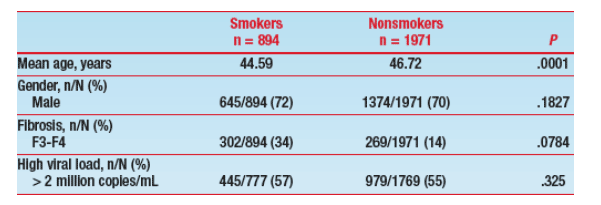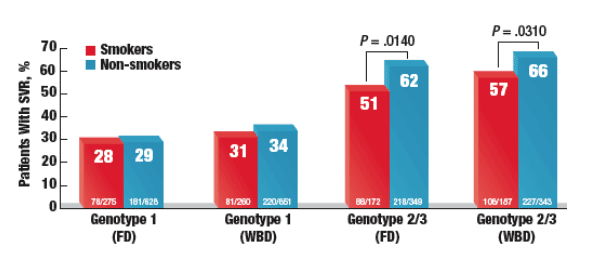 |
 |
 |
| |
Smoking Cigarettes Reduced SVR Rates in Peg/RBV Study
|
| |
| |
The Influence of Cigarette Smoking on Response to Treatment With Pegylated Interferon alfa-2b and Ribavirin in Patients With Chronic Hepatitis C
".....Cigarette smokers with genotype 2 and 3 had lower SVR than nonsmokers. This difference was not seen in the patients with HCV genotype 1..... Smokers with genotype 2/3 had significantly lower SVR rates compared to non-smokers regardless of whether study patients received fixed dose or weight-based dose RBV (FD: 51% vs 62%, p=.0140; WBD: 57% vs 66%, p=.0310)........34% of smokers vs 14% of non-smpokers had more advanced fibrosis (F3-F4), this difference was however not statistically significant (p=.0784)....."
Reported by Jules Levin
DDW, May 2006, Los Angeles
Study authors: M. P. Pauly,1 A. J. Sheinbaum,2 J. Szpakowski,3 J. B. Ready,4 R. S. Brown,5 B. Freilich,6 N. Afdhal,7 P. Kwo,8 J. Santoro,9 S. Becker,10 I. Jacobson,11 L. Griffel,12 C. Brass12
Gasteroenterology, Kaiser Permanente, 1Sacramento, California; 2Los Angeles, California; 3Hayward, California; 4Santa Clara, California; 5Columbia University College of Physicians and Surgeons, New York, New York; 6Baptist Medical Center, Kansas City, Missouri; 7Beth Israel Deaconess Medical Center, Boston, Massachusetts;
8Indiana University, Indianapolis, Indiana; 9Atlantic Gastroenterology Associates, Egg Harbor Township, New Jersey; 10Austin Gastroenterology, PA, Austin, Texas; 11Weill Medical College of Cornell University, New York, New York; 12Schering-Plough Research Institute, Kenilworth, New Jersey
The aim of this analysis was to evaluate the characteristics and response to therapy of HCV infected patients who smoked cigarettes and were treated with pegylated-interferon (PEG IFN) alfa-2b and ribavirin (RBV), compared with those who did not smoke cigarettes. The WIN-R study randomized 4913 patients to either PEG IFN alpha 2b and RBV 800 mg (FD) or RBV 800-1400 mg (WBD) (Jacobson, AASLD 2005). Patients with genotype 1 and 4 were treated for 48 weeks. Patients with genotype 2 or 3 were further randomized to 24 vs 48 weeks of therapy. Sustained viral response (SVR) was the primary endpoint with primary efficacy analysis including those patients who were over 65 kg.
Results showed that weight based dosing resulted in significantly greater SVR, especially in those with genotype 1 and that 24 weeks of therapy for genotype 2 and 3 was as effective as 48 weeks. During enrollment, it was noted whether patients were smokers or nonsmokers. Smoking data was available on 2865 of 4223 (67.8%) patients included in the primary efficacy analysis, those patients who weighed greater than 65 kg. We evaluated the influence of smoking on SVR.
Results: Of the patients with available data, there were 894 (31.2%) smokers and 1971 (68.8%) nonsmokers. The SVR of smokers and nonsmokers in each group is noted in table 1. Smokers with genotype 2/3 had significantly lower SVR rates compared to non-smokers regardless of whether study patients received fixed dose or weight-based dose RBV (FD: 51% vs 62%, p=.0140; WBD: 57% vs 66%, p=.0310).

BACKGROUND
- Treatment of chronic hepatitis C with pegylated interferon alfa-2b (PegIntron) and ribavirin is associated with sustained viral response (SVR) rates greater than 50%
- Successful treatment is influenced by hepatitis C virus (HCV) genotype, stage of fibrosis, gender, and viral load
- Many patients with HCV are active cigarette smokers, and small studies have shown that cigarette smoking is associated with increased hepatic inflammation1,2 and fibrosis2 in this population
In this study reported at EASL 2004, "Daily Cannabis Smoking as a Risk Factor for Fibrosis Progression in Chronic Hepatitis C", investigators concluded: "....This study shows a strong link between daily cannabis consumption and fibrosis progression rate in patients with chronic hepatitis C....... Daily cannabis consumption should be avoided in patients with chronic hepatitis C. In multivariate analysis, fibrosis progression rate >0.08 U per year was independently related to a 4 times greater risk from daily cannabis smoking...."
www.natap.org/2005/HCV/062705_01.htm
- Few studies have explored the effect of cigarette smoking on response to treatment with pegylated interferon alfa and ribavirin
- A small Egyptian study showed that smokers had a lower response rate than nonsmokers to treatment with interferon monotherapy3
- The WIN-R study was a large, community-based, US clinical trial in which patients with HCV were randomized to pegylated interferon (PEG-IFN) alfa-2b 1.5
_g/kg/wk plus either ribavirin 800 mg/day (fixed dosing [FD]) or ribavirin 800 mg/day to 1400 mg/day (weight-based dosing [WBD])
- Results showed that WBD resulted in significantly greater SVR than FD in patients with genotype 1 (34% vs 29%, P = .004) and that 24-week therapy for genotypes 2 and 3 was as effective as 48-week therapy4
WIN-R Study: final results of Weight-Based dosing study of ...Here is link to report on WIN-R Study presentation at AASLD Nov 2005 written by Jules Levin
www.natap.org/2005/AASLD/aasld_59.htm
AUTHOR SUMMARY of Study Results
- Cigarette smokers with genotypes 2 and 3 had a significantly lower SVR than nonsmokers. This difference was not observed in the patients with HCV genotype 1
- The difference in SVR observed between FD and WBD in smokers with HCV genotype 2 or 3 was not significant
- Smokers enrolled in the WIN-R study were slightly but significantly younger than nonsmokers
- Smokers had a marginally higher percentage F3-F4 fibrosis than nonsmokers
Author Conclusions
- The SVR in smokers with HCV genotype 2 or 3 was significantly lower than in nonsmokers. This was not observed in smokers with HCV genotype 1. The lower SVR observed in smokers with HCV genotypes 2 and 3 was not accounted for by stage of fibrosis, gender, or viral load
- Additional studies are needed to evaluate the dose-related effects of cigarette smoking and the effect on SVR of smoking cessation prior to treatment
RESULTS
Table 1. Characteristics of Patients With HCV Genotypes 1, 2, and 3: Comparison Between Smokers and Nonsmokers
In the table 34% of smokers vs 14% of non-smpokers had more advanced fibrosis (F3-F4), this difference was however not statistically significant (p=0784).

Figure 3. SVR rates in smokers and nonsmokers stratified by HCV genotype
In the table you can see smokers with genotype 2/3 had significantly lower SVR rates compared to non-smokers regardless of whether study patients received fixed dose or weight-based dose RBV (FD: 51% vs 62%, p=.0140; WBD: 57% vs 66%, p=.0310).

- The SVRs of smokers and nonsmokers in each group are noted in Figure 3
- Within genotypes 2 and 3 (for smokers and nonsmokers), the differences in SVR between FD and WBD were not significant (P = .480)
- Regression analyses were used to investigate the potential effect of differences in demographic variables (Table 1) on SVR between smokers and nonsmokers
- There was no significant interaction between smoking and any of the demographic variables that could potentially influence SVR
- However, when smoking status was excluded, gender, stage of fibrosis, and viral load influenced SVR
Additional Results
A total of 4913 patients with chronic HCV were randomized to pegylated interferon alfa-2b plus either ribavirin 800 mg (FD) or ribavirin 800 mg/day to 1400 mg/day (WBD) (Figure 2)
- Smoking data were available for 2865 (67.8%) of 4223 patients with HCV genotype 1, 2, or 3 who were included in the primary efficacy analysis
-- Of patients with available data, 894 (31.2%) were smokers and 1971 (68.8%) were nonsmokers
- Baseline characteristics of smokers and nonsmokers are presented in Table 1
- Smokers enrolled in the WIN-R study were slightly but significantly younger (44.6 years) than the nonsmokers (46.7 years) (P < .0001)
- No significant difference in gender distribution was observed between smokers and nonsmokers; 645 (72%) of 894 and 1374 (70%) of 1971 were men, respectively
- 302 of (34%) 894 of smokers had a fibrosis score of F3-F4 and 269 (14%) of 1971 of nonsmokers had a fibrosis score of F3-F4; smokers were marginally more likely (P = .07) to have a higher fibrosis score than nonsmokers
- There was no significant difference in the number of smokers and nonsmokers with high viral load at onset of therapy
- Smokers were more likely to have either genotype 2 or 3 (40%) than nonsmokers (35%) (P = .0094)
References
1. Hezode C, et al. Gut. 2003;52:126-129.
2. Pessione F, et al. Hepatology. 2001;34:121-125.
3. El-Zayadi A, et al. World J Gastroenterol. 2004;10:2963-2966.
4. Jacobson IM, et al. Hepatology. 2005;42:4(supp 1):749A.
|
| |
|
 |
 |
|
|